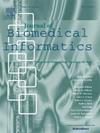揭示痴呆中隐藏的亚型:一种用于痴呆诊断和个性化护理的无监督机器学习方法。
IF 4
2区 医学
Q2 COMPUTER SCIENCE, INTERDISCIPLINARY APPLICATIONS
引用次数: 0
摘要
目的:痴呆症是一项日益严峻的公共卫生挑战,影响着越来越多的人。它包括从轻度到重度的各种认知障碍,每种障碍都需要不同程度的护理。目前的诊断方法通常将痴呆症作为一种统一的病症,可能会忽略临床上重要的亚型,从而限制了治疗和护理策略的有效性。本研究试图解决传统诊断方法的局限性,将无监督机器学习技术应用于痴呆症患者的大型多模态数据集(包括临床、人口统计学、基因表达和蛋白质浓度等多种数据源),目的是识别人群中的独特亚型。主要重点是区分痴呆症的轻度和重度阶段,以提高诊断准确性和个性化治疗方案:分析的数据集包括 911 名个体,由 157 个多模式特征描述,包括临床、基因组、蛋白质组和社会人口学特征。处理缺失数据后,数据集缩减为 561 行 135 列。我们采用了各种降维技术来提高特征与患者的比例,并采用无监督聚类方法来识别潜在的亚型。我们的方法的主要创新点在于将不同的技术结合起来,在高维统计推断、多模态降维和聚类分析之间架起桥梁,以适当地模拟数据的多模态性质并确保临床相关性:分析结果表明,痴呆症人群中存在不同的聚类,每个聚类都有特定的临床和人口特征。这些特征包括生物标志物、认知评分和残疾程度的差异。研究结果表明,存在以前未曾认识到的亚群,这些亚群由基因组、蛋白质组和临床特征区分开来:这项研究表明,无监督机器学习能有效识别痴呆症的临床相关亚型,对诊断和个性化治疗具有重要意义。要验证这些发现并研究其改善患者预后的潜力,还需要进一步的研究。本文章由计算机程序翻译,如有差异,请以英文原文为准。

Uncovering hidden subtypes in dementia: An unsupervised machine learning approach to dementia diagnosis and personalization of care
Objective:
Dementia represents a growing public health challenge, affecting an increasing number of individuals. It encompasses a broad spectrum of cognitive impairments, ranging from mild to severe stages, each of which demands varying levels of care. Current diagnostic approaches often treat dementia as a uniform condition, potentially overlooking clinically significant subtypes, which limits the effectiveness of treatment and care strategies. This study seeks to address the limitations of traditional diagnostic methods by applying unsupervised machine learning techniques to a large, multi-modal dataset of dementia patients (encompassing multiple data sources including clinical, demographic, gene expression and protein concentrations), with the aim of identifying distinct subtypes within the population. The primary focus is on differentiating between mild and severe stages of dementia to improve diagnostic accuracy and personalize treatment plans.
Methods:
The dataset analyzed included 911 individuals, described by 157 multi-modal characteristics, encompassing clinical, genomic, proteomic and sociodemographic features. After handling missing data, the dataset was reduced to 561 rows and 135 columns. Various dimensionality reduction techniques were applied to improve the feature-to-patient ratio, and unsupervised clustering methods were employed to identify potential subtypes. The major novelty in our methodology regards the combination of different techniques, bridging high-dimensional statistical inference, multi-modal dimensionality reduction and clustering analysis, to appropriately model the multi-modal nature of the data and ensure clinical relevance.
Results:
The analysis revealed distinct clusters within the dementia population, each characterized by specific clinical and demographic profiles. These profiles included variations in biomarkers, cognitive scores, and disability levels. The findings suggest the presence of previously unrecognized subgroups, distinguished by their genomic, proteomic, and clinical characteristics.
Conclusion:
This study demonstrates that unsupervised machine learning can effectively identify clinically relevant subtypes of dementia, with important implications for diagnosis and personalized treatment. Further research is required to validate these findings and investigate their potential to improve patient outcomes.
求助全文
通过发布文献求助,成功后即可免费获取论文全文。
去求助
来源期刊

Journal of Biomedical Informatics
医学-计算机:跨学科应用
CiteScore
8.90
自引率
6.70%
发文量
243
审稿时长
32 days
期刊介绍:
The Journal of Biomedical Informatics reflects a commitment to high-quality original research papers, reviews, and commentaries in the area of biomedical informatics methodology. Although we publish articles motivated by applications in the biomedical sciences (for example, clinical medicine, health care, population health, and translational bioinformatics), the journal emphasizes reports of new methodologies and techniques that have general applicability and that form the basis for the evolving science of biomedical informatics. Articles on medical devices; evaluations of implemented systems (including clinical trials of information technologies); or papers that provide insight into a biological process, a specific disease, or treatment options would generally be more suitable for publication in other venues. Papers on applications of signal processing and image analysis are often more suitable for biomedical engineering journals or other informatics journals, although we do publish papers that emphasize the information management and knowledge representation/modeling issues that arise in the storage and use of biological signals and images. System descriptions are welcome if they illustrate and substantiate the underlying methodology that is the principal focus of the report and an effort is made to address the generalizability and/or range of application of that methodology. Note also that, given the international nature of JBI, papers that deal with specific languages other than English, or with country-specific health systems or approaches, are acceptable for JBI only if they offer generalizable lessons that are relevant to the broad JBI readership, regardless of their country, language, culture, or health system.
 求助内容:
求助内容: 应助结果提醒方式:
应助结果提醒方式:


